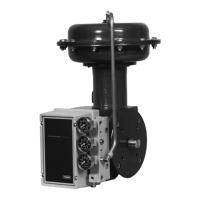Type 1051 & 1052 Styles H & J
21
the output shaft with the cap screw (key 28). Tight-
en the cap screw to the torque value listed in table
7.
d. Rotate the lever and output shaft back to the
original position, and then adjust the rod end bear-
ing so that it can be attached to the lever.
7. Apply Loctite 271 or equivalent thread-locking com-
pound (key 77) to the threads of the cap screw (key
18).
8. Connect the lever (key 27) and the rod end bearing
(key 17) with the cap screw and hex nut (keys 18 and
19). This connection can be aided by stroking the ac-
tuator from its up travel stop with a regulated air
source. Tighten the cap screw to the torque value
listed in table 7.
9. Note the position of the valve body or other oper-
ated equipment and direction of rotation. Position the
travel indicator (key 37) accordingly. Replace the cov-
er (key 33), and secure it with the cap screws and
washers (keys 34 and 63). If the holes in the cover
and housing (key 20) do not align, use a regulated air
source to move the actuator slightly off the up travel
stop. If hole alignment cannot be obtained in this man-
ner, temporarily loosen the cap screws (key 23), and
shift the housing slightly. Do not stroke the actuator
while the cover is off. Then, tighten both sets of cap
screws to the torque values listed in table 7.
10. Follow the instructions in the Adjustment section
for turnbuckle adjustment.
Top-Mounted Handwheels and
Adjustable Travel Stops
Handwheel and Travel Stop Operation
Note
If repeated or daily manual operation is
expected or desired, the unit should be
equipped with a manual handwheel ac-
tuator. Refer to the separate manual
handwheel actuator instruction manual
for mounting instructions.
The top-mounted handwheel assembly is attached to
a special upper diaphragm casing (key 1, figures 10
and 11) with cap screws (key 141, figure 13). A hex
nut (key 137, figure 13) locks the handwheel in posi-
tion.
Turning the handwheel (key 51, figure 13) clockwise
into the upper diaphragm casing forces the pusher
(key 135, figure 13) against the diaphragm and dia-
phragm plate (keys 3 and 4, figures 10 and 11) to
compress the spring (key 11, figures 10 and 11) and
move the diaphragm rod downward. Turning the hand-
wheel counterclockwise allows the actuator spring to
move the diaphragm rod upward. If the action is push-
down-to-close, full opening can be restricted by posi-
tioning the handwheel at the desired position. If the
action is push-down-to-open, full closing can be re-
stricted by use of the handwheel.
The adjustable up travel stop (figure 14) limits the ac-
tuator stroke in the upward direction. To make adjust-
ments, first relieve actuator loading pressure before
removing the closing cap (key 187) as it is a pressure
retaining part. Also, for size 70 actuators, the hex nut
(key 137) must be loosened.
Then turn the stem (key 133) clockwise into the dia-
phragm case to move the actuator stem downward or
counterclockwise to allow the spring to move the ac-
tuator stem upward. If the action is push-down-to-
close, full opening can be restricted; or if the action is
push-down-to-open full closing can be restricted by the
position of the adjustable travel stop. Tighten the hex
nut (for size 70), and replace the closing cap after ad-
justment.
The adjustable down travel stop (figure 15) limits the
actuator stroke in the downward direction. To make
adjustments, first relieve actuator loading pressure
before removing the closing cap (key 187) as it is a
pressure retaining part. After removing the closing cap
loosen the hex jam nut (key 189) and either turn the
hex nut (key 63 for size 30, 40, and 70 actuators; or
key 54 for size 60 actuators) down on the stem (key
133) to limit travel, or up on the stem to allow more
travel. Lock the jam nut against the hex nut, and re-
place the closing cap after the adjustment has been
made.
Handwheel and Travel Stop Maintenance
WARNING
Avoid personal injury or property dam-
age from a sudden release of pressure
or uncontrolled process fluid. Before
starting disassembly:
D Isolate the valve or other operated
equipment from the process,
D Release process pressure, and
D Vent the actuator loading pressure.
If loading pressure seems to be leaking from either the
handwheel or adjustable up stop, the O-rings (key 138
and 139, figures 13 and 14) may need replacement. If
the adjustable down stop leaks, the O-ring (key 139,

